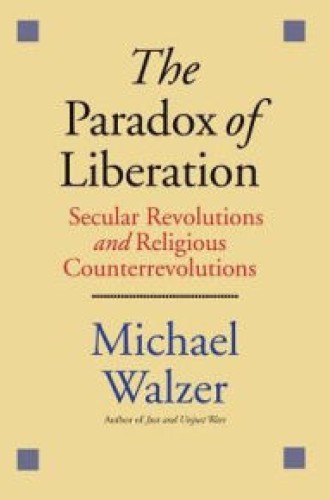The Paradox of Liberation, by Michael Walzer
Over his long career as a political philosopher, Michael Walzer has probed issues of power and truth, and he has kept in purview the moral-theological dimension of such questions from a perspective rooted in his own Jewish tradition. This modest volume was originally his Henry L. Stimson Lectures at Yale. The name of Stimson, secretary of war during World War II, suggests an urbane, unblinking, critical reflection on power as it is channeled through nation-states.
Walzer addresses the interplay between social revolutions that he regards as secular and reactive counterrevolutions that have deep roots in religious tradition. He weaves in and out among three case studies: the founding of the state of Israel, the emancipation of Algeria by the National Liberation Front, and the independence of India from the British Empire. Walzer knows most about the case of Israel, less about India, and least about Algeria. But his typology suggests that the same historical-political dynamics operate in each case.
Read our latest issue or browse back issues.
Walzer’s sympathies are all on the side of the liberation movements led by those he tags as militants. In each case cited, the liberation movement was led by people who had been schooled in the secular Enlightenment culture of the oppressors and who championed a form of liberation that could respond effectively to a context of oppression. In each case, however, that liberation was an imposition that lacked intimate contact with the culture of those whom the militants genuinely sought to liberate. And because each liberation was imposed from a perspective inimical to indigenous religious tradition and was not at all negotiated, the militants were regularly followed or responded to by “zealots” who championed old traditions and resisted many of the assumptions of the secular liberationists.
In the case of the founding of Israel, Walzer judges that the founding “Zionism was, and could only be, the creation of people who were hostile to Judaism.” The secularists had to fight against a Judaism that from the time of the exile had become adaptive to captivity and submissively cooperative with imperial overlords. That propensity to adaptation had to be overcome if there was to be energy and courage for independence. In Israel the response of the zealots has been in the form of ultraorthodoxy, with a political aggressiveness among the “settlers,” who are deeply committed to the old religious claims concerning the land of promise.
On two counts Walzer’s presentation presents difficulties. First, the categories of secular and religious are slippery. As he knows, there is a latent religious element even in the secular movements, so his argument serves best in a heuristic way. Second, I suppose because the essays were originally presented as lectures, they are informal to the point of breeziness, which makes the argument sometimes difficult to follow.
That said, Walzer’s argument is of immense interest and importance. With his analysis of secular versus religious movements and of militants versus zealots, he brings us immediately up to date with issues now being faced in these and many other cultures. It is not clear, for example, how the vision of a secular, democratic Israel with rights for Palestinians can be sustained in the face of unrestrained traditionalist passions. Likewise, in India it is far from clear how a democratic state will be guaranteed in the presence of zealous Hinduism that is intolerant of a Muslim presence. The founding secularists knew that an accommodation had to be made for those populations that would continue to be a significant political presence, while the zealots, propelled by tradition-become-ideology, have little interest in such realism.
Walzer’s suggested way forward is to recognize that instead of stridently imposing their agenda, secularists need to negotiate with traditionalists, especially to discern ways that “the old oldness may have been more pluralistic, more accepting of difference (in practice if not in doctrine), than either the secular liberationists imagine or the religious zealots admit.” The secularists have, in each case, been propelled by a certain form of Enlightenment rationality, but (quoting Martha Nussbaum) “the liberal state needs public poetry, not just scientific rationality, to sustain itself.” That public poetry can come only from the old traditions. In what seems to me a brilliant maneuver, Walzer, following Antonio Gramsci, recognizes that the hegemony sought by the liberationists must be a “compromised dominance” that “takes into account the interests and tendencies of the groups over which hegemony will be exercised.” Gramsci understood that “hegemonic groups will make some sacrifice.” That, of course, is not easy, because traditional groups are not prepared for such compromises and negotiation.
Walzer’s analysis proposes a map of power that greatly illuminates the contemporary situation. Moreover, he adds an important postscript on the founding population of the United States, which did not engage in such a struggle between “enlightened intellectuals” and “religious people.” Such conflict did not happen in the United States because of the “newness” of American society and the pluralism of religious culture. Though Walzer does not carry his analysis into contemporary issues, his argument might suggest that critical secular liberationists need to reengage the religious traditions with attentiveness to pluralistic and humanizing issues that are voiced in the traditions even if they are largely disregarded by the religious zealots in our midst.
Walzer suggests that equality for women is a recurring litmus test for liberation movements. Religious countermovements characteristically (and certainly in the United States) seek to curb such liberation for women.
The large takeaway from this rich book is that reengagement between religious tradition and scientific rationality is an urgent task requiring modesty and humility, traits not generally found among either zealots or militants. Given Walzer’s worldly wisdom, I can imagine that Henry Stimson would applaud these lectures that honor his legacy.






